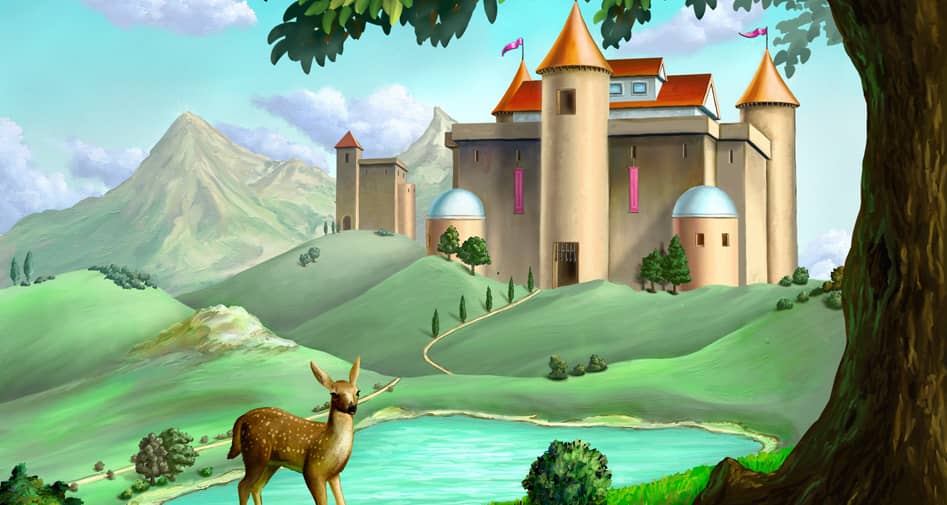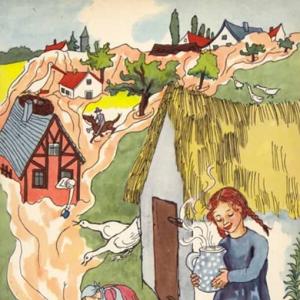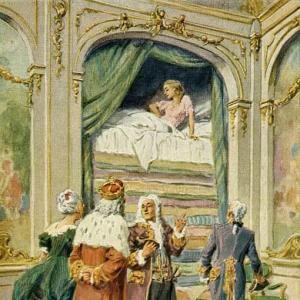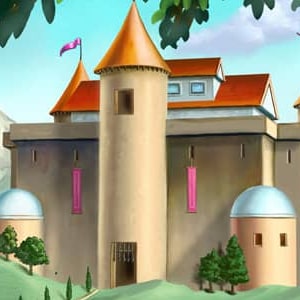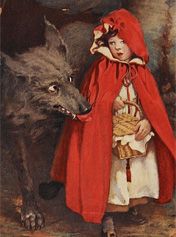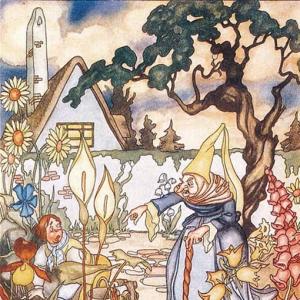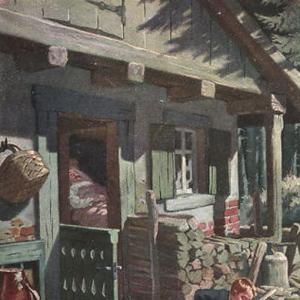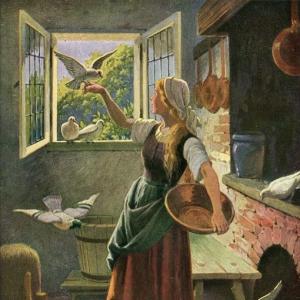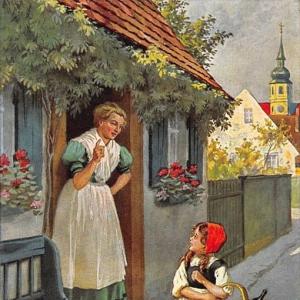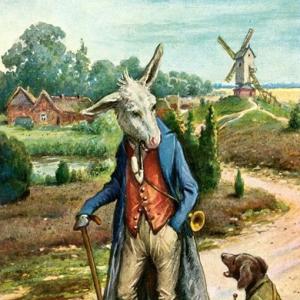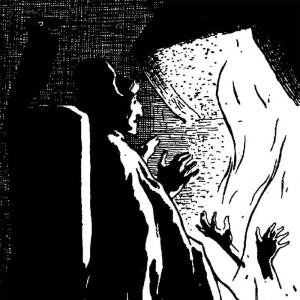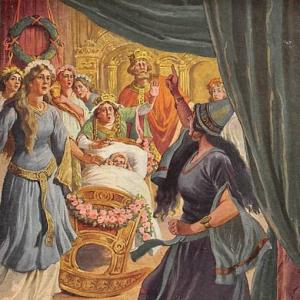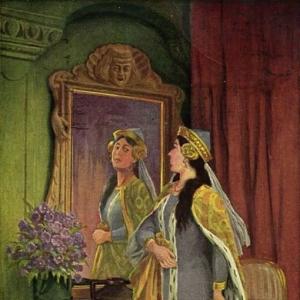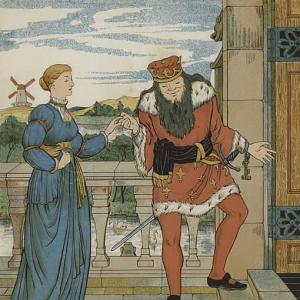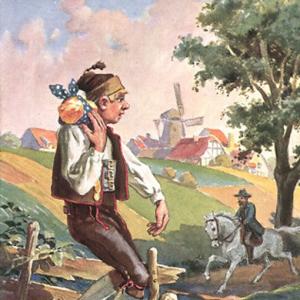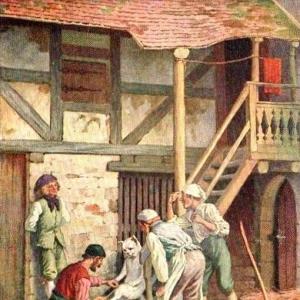Reading time for children: 15 min
It is unbelievable all that children know nowadays. One can scarcely say what they don’t know. They no longer believe the old story that the stork brought them to father and mother out of the well or the millpond when they were little, and yet it is really true. But how did the little ones get down into the millpond or the well? Ah, not everyone knows that, but there are some who do. Have you ever gazed at the sky on a clear, starry night and watched the many shooting stars?
It is as if the stars fall from and disappear into nowhere. Even the most learned persons can’t explain what they don’t know themselves; but one can explain this when he knows it. It is like a little Christmas-tree candle that falls from heaven and is blown out. It is a soul spark from our Lord that flies toward the earth, and when it reaches our thick, heavy air, it loses its brilliancy, becoming something that our eyes cannot see, something much finer than air itself.
It is a little child from heaven, a little angel, but without wings, for it is to become a human child. Softly it glides through the air, and the wind carries it into a flower, which may be an orchid, a dandelion, a rose, or a cowslip, and there it lies and rests itself. And so light and airy is it that a fly can carry it off, as, of course, a bee can, when they alternately come to seek the sweetness of the flower. If the little air child lies in their way, they do not brush it aside.
That they wouldn’t have the heart to do! They take it and lay it under the leaf of a water lily in the sunshine, and from there it crawls and creeps into the water, where it sleeps and grows until it is large enough for the stork to see and bring to a human family that has been longing for a sweet little child. But whether it becomes sweet or not depends on whether it has drunk pure clean water or has swallowed mud and duckweed the wrong way. That makes one so filthy!
The stork, always without preference, takes the first one he sees. One goes to kind and loving parents in a fine home; another comes to unpleasant people in such misery that it would have been much better for it to have remained in the millpond. The little ones can never remember afterward what they dreamed while they were lying under the water-lily leaf, listening to the frogs in the evening singing, „Coax! Coax! Coax!“ In human language that means, „Now you go to sleep and dream!“
Nor can they remember the flower where they first lay, nor how it smelled; and yet there is always something inside them, even when they are grown people, which makes them say, „I like this flower the best.“ That’s because it is the one in which they were placed when they were air children. The stork lives to be a very old bird, and he always has interest in the little ones he has brought and watches how they get along in the world and how they behave themselves.
Of course, he can’t do much for them or change anything in their lives, for he has his own family to look after, but at least he never lets them get out of his thoughts. I know a very worthy, honest old stork who has had a great deal of experience, and has brought many little ones out of the water, and knows their stories – in which there is always a little mud and duckweed from the millpond. I begged him to tell me the story of one of them, and he said I should have three instead of one, and all from the Pietersens‘ house.
The Pietersens were an extremely nice family. The father was one of the thirty-two members of the town council, and that was an honor. He was completely wrapped up in his work with the thirty-two councilmen. When the stork brought a little fellow to this home he was named Peiter. The next year the stork brought another, and they named him Peter, and when the third one came they called him Peer – for all three names – Peiter, Peter, and Peer – are parts of the name Pietersen.
So there were three brothers here – three shooting stars – and each had been cradled in a flower, then laid under the water-lily leaf in the millpond, and brought from there by the stork to the Pietersen family, whose house is on the corner, as you surely know. They grew in body and mind, and wanted to become something more than the thirty-two councilmen were. Peiter had decided he wanted to be a robber. He had just seen the play Fra Diavolo, and that had convinced him that a robber’s life was the most delightful in the world.
Peter wanted to be a trash collector. And Peer, who was such a sweet and good boy, round and plump, whose only fault was biting his nails, wanted to be „Papa.“ That was what each of them said he was going to be in life, whenever anybody asked them about it. Then they went to school. One was at the head of the class, and one at the foot, and one in the middle, but in spite of that they could be equally good and clever, and they were, said their very clearsighted parents.
The three went to children’s parties. They smoked when nobody was watching. They gained knowledge and made acquaintances. From the time he was quite small, Peiter was quarrelsome, just the way a robber ought to be. He was a very naughty boy, but his mother said that came from worms – naughty children always have worms – or from mud in the stomach. And one day his mother’s new silk dress suffered from his obstinacy and naughtiness.
„Don’t push the tea table, my good little lamb,“ she had said. „You might tip over the cream pitcher, and then I’d get spots on my new silk dress.“ And so the „good little lamb“ firmly took up the cream pitcher and firmly poured all the cream right into Mamma’s lap. Mamma couldn’t help saying, „Oh, lamb, lamb, that was careless of you, lamb!“ But she had to admit that the child had a will of his own. A will means character, and that’s very promising to a mother.
He might, of course, have become a robber, but he didn’t, in the actual sense of the word. He only came to look like one, with his slouch hat, bare throat, and long, lank hair. He was supposed to be an artist, but he only got as far as the clothes. He looked like a hollyhock, and all the people he made drawings of looked like hollyhocks, so lanky were they. He was very fond of hollyhocks, and the stork said he had lain in that flower when he was an air child.
Peter must have lain in a buttercup. He looked buttery around the corners of his mouth, and his skin was so yellow that one would think that if his cheek were cut, butter would ooze out. He should have been a butter dealer, and could have been his own signboard; but on the inside he was a trash collector with a rattle. He was a musician of the Pietersen family – „musical enough for all of them,“ the neighbors said. He composed seventeen new polkas in one week, and then put them all together and made an opera out of them, with a trumpet and rattle accompaniment. Ugh! How delightful that was!
Peer was white and red, small and quite ordinary. He had lain in a daisy. He never hit back when the other boys beat him up. He said he was the most sensible, and the most sensible always gives way first. He was a collector, first of slate pencils, and later of letter seals. Then he got a little cabinet of curiosities of natural history, in which were the skeleton of a stickleback, three blind baby rats preserved in alcohol, and a stuffed mole.
Peer had a keen appreciation of science and an eye for the beauties of nature, and that was a comfort to his parents and to him, too. He preferred wandering in the woods to going to school, preferred nature to education. Both his brothers were engaged to be married, but he could think of nothing but completing his collection of water-bird eggs. He knew much more about animals than he did about human beings. He even thought we could never reach the heights of the animals in the feeling we consider the loftiest of all – love.
He saw that when the female nightingale was setting on the nest, Papa Nightingale would perch on a branch close by and sing to his little wife all night, „Kluk-kluk! Zi-Zi! Lo-lo-li!“ Peer knew he could never do that or even think of doing such a thing. When Mamma Stork had her babies in the nest, Father Stork stood guard on the edge of the roof all night, on one leg. Peer couldn’t have stood that way for an hour!
Then one day when he examined a spider’s web, and saw what was in it, he gave up completely any idea of marriage. Mr. Spider weaves his web for catching thoughtless flies, old and young, fat and lean. He lives only to weave and to support his family. But Madam Spider lives only for him. Out of sheer love she eats him up. She eats his heart, his head, his stomach, until only his long thin legs are left in the web where he used to sit, anxious for the welfare of his family.
Now that’s the real truth, right out of the natural-history book! When Peer saw all this he grew very thoughtful. To be so dearly loved by a wife that she eats one up out of violent love? No! No human being could love like that, and would it be desirable, anyway? Peer resolved never to marry, or even to give or take a kiss, for that might seem the first step toward marriage. But he did receive a kiss, anyway, the same kiss we all get someday, the great kiss of Death.
When we have lived long enough, Death is given the order, „kiss him away,“ and so away the human goes. A ray of sunshine comes straight from our Lord, so bright that it almost blinds one. Then the soul that came from heaven as a shooting star goes back like a shooting star, but this time not to sleep in a flower or dream beneath the leaf of the water lily. It has more important things than that to do. It enters the great land of eternity; but what that is like and what it looks like there, no one can say.
No one has looked into it, not even the stork, though he sees far and knows much. The stork knew nothing more of Peer, whereas he could have told me lots more about Peiter and Peter. But I had heard enough of them, and I suppose you have, too, so I thanked him and bade him good-by for this time. But now he demands three frogs and a little snake as payment for this simple little story – you see, he takes his pay in food. Will you pay him? I can’t. I have neither frogs nor snakes.
 Learn languages. Double-tap on a word.Learn languages in context with Childstories.org and Deepl.com.
Learn languages. Double-tap on a word.Learn languages in context with Childstories.org and Deepl.com.Backgrounds to fairy tale „Peiter, Peter, and Peer“
Peiter, Peter, and Peer“ is a lesser-known fairy tale by Hans Christian Andersen, a prolific Danish author who lived in the 19th century. Andersen is best known for his timeless and imaginative stories that often contain moral lessons, exploring themes like love, human nature, and the meaning of life. His works have been translated into numerous languages and have inspired countless adaptations in various forms, including films, plays, and ballets.
Hans Christian Andersen was born in 1805 in Odense, Denmark, and overcame humble beginnings to become one of the most famous authors of his time. He began publishing his fairy tales in 1835, and by the time of his death in 1875, his stories had gained widespread recognition and popularity. Some of Andersen’s most famous works include „The Little Mermaid,“ „The Ugly Duckling,“ „The Snow Queen,“ „Thumbelina,“ and „The Emperor’s New Clothes.“ These stories often feature magical elements and anthropomorphic animals, as well as protagonists who undergo personal transformations or learn valuable life lessons.
In „Peiter, Peter, and Peer,“ Andersen presents a unique take on the concept of destiny and human nature through the adventures and aspirations of the three brothers. The story reflects Andersen’s characteristic use of imaginative elements, such as the idea of air children and the wise old stork, to create a fantastical world that is both engaging and thought-provoking. „Peiter, Peter, and Peer“ emphasizes the importance of unity, cooperation, and brotherhood. It shows how individual strengths can complement each other when working together, resulting in a stronger, more successful outcome. The story celebrates the power of family and the value of relying on one another in times of need.
Interpretations to fairy tale „Peiter, Peter, and Peer“
„Peiter, Peter, and Peer“ is a fairy tale that can be interpreted in various ways. Some of the key themes and interpretations are as follows:
Individuality and personal paths: The story showcases the unique personalities and aspirations of the three brothers. Each brother has a different path in life, and their individuality is emphasized through their distinct dreams and experiences. This theme suggests that everyone has their own journey, and there is no single path to success or happiness.
Nature and its influence on human life: The story highlights the connection between nature and human life through the concept of air children lying in flowers before being brought to their families. The brothers‘ personalities are linked to the flowers in which they were placed, showing how nature can influence and shape human lives.
The limitations of human understanding: Peer’s fascination with the natural world leads him to compare human love with the love displayed by animals. This comparison ultimately leads him to reject the idea of marriage. The story suggests that humans might not be able to fully understand the complexities of love or the natural world, and that our understanding is limited by our perspective.
The inevitability of death: The tale also touches upon the theme of mortality, as Peer eventually receives the kiss of Death. The story serves as a reminder that death is an inevitable part of life, and the soul’s journey continues beyond this world into the realm of eternity.
The power of storytelling: The wise old stork serves as a storyteller, sharing the stories of the three brothers with the narrator. This element of the tale highlights the importance of storytelling in preserving memories and sharing experiences.
Overall, „Peiter, Peter, and Peer“ offers valuable lessons on the power of unity, the importance of family, and the potential for personal growth when individuals embrace their unique qualities and work together to overcome challenges.
Adaptions of the fairy tale „Peiter, Peter, and Peer“
Adaptations of „Peiter, Peter, and Peer“ by Hans Christian Andersen are less common compared to some of his other fairy tales. However, the story has been retold and adapted in various ways, primarily in book formats or anthologies, which often include illustrations to engage young readers.
Literature: One example is „Peiter, Peter, and Peer“ in „Hans Andersen’s Fairy Tales: A Selection“ (Oxford University Press, 2011), translated by L. W. Kingsland. This book features a collection of Hans Christian Andersen’s fairy tales, including the story of the three brothers, making it accessible to modern readers.
Theater: The story has been adapted into a play by various theatre companies around the world. For example, in 2015, a theatrical production of the story was performed at the Hampstead Theater in London, UK.
Film and television: There have been several adaptations of the story for film and television. In 1963, the Soviet animated film „Three Masters“ was released, which was based on the story. In 2016, a short film titled „Peer & Peter“ was released, which was a modern-day retelling of the story. While there aren’t any specific movie or television adaptations of „Peiter, Peter, and Peer,“ it is possible that elements of the story have inspired other works or have been combined with other fairy tales to create new stories.
Literature: The story has also inspired various children’s books, including „Peiter, Peter, and Peer: Three Brothers with Different Talents“ by Pauline Quirke and „Three Wise Masters“ by Marcia Brown.
Music: The story has also inspired various musical adaptations, including a chamber opera titled „Peiter, Peter and Peer“ by composer Poul Ruders and librettist Becky Starobin.
Art: The story has also inspired various works of art, including paintings, illustrations, and sculptures. For example, in 2020, artist and illustrator Sveta Dorosheva created a series of illustrations inspired by the story.
The fairy tale „Peiter, Peter, and Peer“ by Hans Christian Andersen has inspired various adaptations in different forms of media. These adaptations involve modernizing the language, simplifying the story for younger audiences, or even adding new elements to make the tale more appealing to contemporary readers.
Summary of the plot
„Peiter, Peter, and Peer“ is a fairy tale by Hans Christian Andersen that revolves around three brothers, who were brought to the Pietersen family by a wise old stork. The brothers, Peiter, Peter, and Peer, all have different aspirations in life. Peiter wants to become a robber, Peter a trash collector, and Peer desires to be „Papa.“ As they grow, the brothers take on different paths. Peiter becomes an artist known for his drawings of hollyhocks, Peter becomes a musician composing polkas and operas, while Peer develops a keen interest in natural history and decides never to marry.
Peer’s fascination with the animal world leads him to believe that humans could never reach the heights of love displayed by animals, such as nightingales and storks. After observing the life of spiders, where the female consumes the male out of love, Peer is convinced that he should never marry or even give a kiss. Eventually, Peer receives the inevitable kiss of Death, which sends his soul back to the realm of eternity.
The wise old stork, who brought the brothers into the world, keeps a watchful eye on their lives. Although he can’t change their destinies, he maintains a strong interest in their stories. The stork shares the stories of the three brothers with the narrator, who thanks the stork for the tale but struggles to provide the payment of three frogs and a little snake, as the stork desires.
Informations for scientific analysis
Fairy tale statistics | Value |
|---|---|
| Translations | DE, EN, DA, ES |
| Readability Index by Björnsson | 28.7 |
| Flesch-Reading-Ease Index | 79.7 |
| Flesch–Kincaid Grade-Level | 6.5 |
| Gunning Fog Index | 9.2 |
| Coleman–Liau Index | 8 |
| SMOG Index | 9 |
| Automated Readability Index | 6.5 |
| Character Count | 10.274 |
| Letter Count | 7.923 |
| Sentence Count | 111 |
| Word Count | 1.956 |
| Average Words per Sentence | 17,62 |
| Words with more than 6 letters | 216 |
| Percentage of long words | 11% |
| Number of Syllables | 2.525 |
| Average Syllables per Word | 1,29 |
| Words with three Syllables | 111 |
| Percentage Words with three Syllables | 5.7% |
